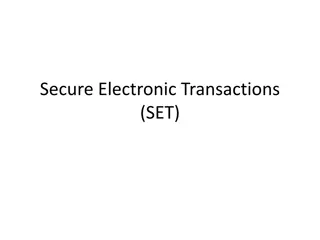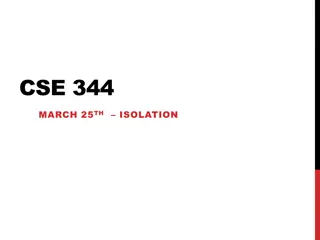Understanding Properties of Database Transactions
Database transactions play a crucial role in ensuring data integrity and consistency within a database system. This content explores the fundamental properties of transactions, such as atomicity, durability, consistency, and isolation. It delves into the requirements and implications of each property, emphasizing the importance of maintaining the integrity of data during transaction execution. The concept of transaction atomicity, where all operations within a transaction must either be fully completed or fully rolled back, is discussed along with the durability requirement for preserving transaction updates despite failures. Consistency requirements, including implicit integrity constraints, are also highlighted, underscoring the need for maintaining a consistent database state throughout transaction processing. Additionally, the isolation requirement for ensuring transaction concurrency without interference is examined, pointing out the significance of maintaining transaction execution independence.
Download Presentation

Please find below an Image/Link to download the presentation.
The content on the website is provided AS IS for your information and personal use only. It may not be sold, licensed, or shared on other websites without obtaining consent from the author. Download presentation by click this link. If you encounter any issues during the download, it is possible that the publisher has removed the file from their server.
E N D
Presentation Transcript
Database System Implementation CSE 507 Introduction to Transactions Some slides adapted from Navathe et. Al. and Silberchatz et. Al.
Transaction Concept A transactionis a unit of program execution that accesses and possibly updates various data items. E.g., transaction to transfer $50 from account A to account B: 1. read(A) 2. A := A 50 3. write(A) 4. read(B) 5. B := B + 50 6. write(B)
Required Properties of a Transaction Transaction to transfer $50 from account A to account B: 1. read(A) 2. A := A 50 3. write(A) 4. read(B) 5. B := B + 50 6.write(B) Atomicity requirement If transaction fails after step 3 and before step 6, money will be lost Updates of a partially executed transaction are not reflected in DB.
Required Properties of a Transaction Durability requirement Once the transaction has been completed, the updates to the database by the transaction must persist even if there are software or hardware failures.
Required Properties of a Transaction Consistency requirement consistency requirements include Implicit integrity constraints e.g., sum of balances of all accounts. Start of a transaction must see a consistent database. During execution the database may be temporarily inconsistent. At completion the database must be consistent Erroneous transaction logic can lead to inconsistency
Required Properties of a Transaction Isolation requirement if between steps 3 and 6, another transaction T2 is allowed to access the partially updated database, it will see an inconsistent database T1 T2 1. read(A) 2. A := A 50 3. write(A) read(A), read(B), print(A+B) 4. read(B) 5. B := B + 50 6. write(B Isolation can be ensured trivially by running transactions serially That is, one after the other. Would that be desirable?
Required Properties of a Transaction Atomicity. Either all operations of the transaction are properly reflected in the database or none are. Consistency. Execution of a transaction in isolation preserves the consistency of the database. Isolation. Although multiple transactions may execute concurrently, each transaction must be unaware of other concurrently executing transactions. Intermediate transaction results must be hidden from other concurrently executed transactions. That is, for every pair of transactions Tiand Tj, it appears to Tithat either Tj, finished execution before Ti started, or Tj started execution after Ti finished. Durability. After a transaction completes successfully, the changes it has made to the database persist, even if there are system failures.
Transaction Concept Two main issues to deal with: Concurrent execution of multiple transactions Concurrency Control Techniques Hardware failures and system crashes Recovery System
Why Concurrency Control? The Lost Update Problem This occurs when two transactions that access the same database items have their operations interleaved in a way that makes the value of some database item incorrect. The Temporary Update (or Dirty Read) Problem This occurs when one transaction updates a database item and then the transaction fails for some reason. The updated item is accessed by another transaction before it is changed back to its original value.
Why Concurrency Control? The Incorrect Summary Problem If one transaction is calculating an aggregate summary function on a number of records while other transactions are updating some of these records, the aggregate function may calculate some values before they are updated and others after they are updated.
Concurrent Executions Concurrency control schemes Set of mechanisms to achieve isolation: Control the interaction among the concurrent transactions in order to prevent them from destroying the consistency of the database.
Concurrent Execution example Let T1 transfer $50 from A to B, and T2 transfer 10% of the balance from A to B. An example of a serial schedule in which T1 is followed by T2: Increasing Time
Concurrent Execution example A serial schedule in which T2 is followed by T1 : Increasing Time
Concurrent Execution example Let T1 and T2 be the transactions defined previously. The following schedule is not a serial schedule, but it is equivalent to Schedule 1. Increasing Time
What is a Schedule? A schedule (or history) S of n transactions T1, T2, , Tn: It is an ordering of the operations of the transactions subject to the constraint that, for each transaction Ti that participates in S, the operations of Ti in S must appear in the same order in which they occur in Ti. Note, however, that operations from other transactions Tj can be interleaved with the operations of Ti in S.
Characterizing Schedules on Serializability Serial schedule: A schedule S is serial if, for every transaction T participating in the schedule, all the operations of T are executed consecutively in the schedule. Otherwise, the schedule is called nonserial schedule. Serializable schedule: A schedule S is serializable if it is equivalent to some serial schedule of the same n transactions.
Characterizing Schedules on Serializability Let li and lj be two Instructions of transactions Ti and Tj respectively. Instructions li and ljconflict if and only if there exists some item Q accessed by both li and lj, and at least one of these instructions wrote Q. 1. li = read(Q), lj = read(Q). li and ljdon t conflict. 2. li = read(Q), lj = write(Q). They conflict. 3. li = write(Q), lj = read(Q). They conflict 4. li = write(Q), lj = write(Q). They conflict
Characterizing Schedules on Serializability Intuitively, a conflict between liand lj forces a (logical) temporal order between them. If li and lj do not conflict, their results would remain the same even if they had been interchanged in the schedule.
Characterizing Schedules on Serializability Result equivalent: Two schedules are called result equivalent if they produce the same final state of the database. Conflict equivalent: Two schedules are said to be conflict equivalent if the order of any two conflicting operations is the same in both schedules. Conflict serializable: A schedule S is said to be conflict serializable if it is conflict equivalent to some serial schedule S .
Serializability Can be transformed into this by moving non- conflicting operations
Serializability Example of a schedule that is not conflict serializable: We are unable to swap instructions in the above schedule to obtain either the serial schedule < T3, T4 >, or the serial schedule < T4, T3 >.
Testing Serializability --- Precedence Graph Consider some schedule of a set of transactions T1, T2, ..., Tn Precedence graph a direct graph where the vertices are the transactions (names). We draw an arc from Tito Tjif the two transaction conflict, and Tiaccessed the data item on which the conflict arose earlier. We may label the arc by the item that was accessed. Example
Testing Serializability A schedule is conflict serializable if and only if its precedence graph is acyclic. If precedence graph is acyclic, the serializability order can be obtained by a topological sorting of the graph. That is, a linear order consistent with the partial order of the graph. For example, a serializability order for the schedule (a) would be one of either (b) or (c)
Why Recovery is needed? 1. A computer failure (system crash): A hardware or software error occurs in the computer system. If the hardware crashes, the contents of the computer s internal memory may be lost. 2. A transaction or system error: Due to an operation in the transaction e.g., division by zero. Erroneous parameter values or because of a logical programming error. the user may interrupt the transaction during its execution.
Why Recovery is needed? 3. Local errors detected by the transaction: Certain conditions necessitate cancellation of the transaction. For example, data for the transaction may not be found 4. Concurrency control enforcement: The concurrency control method may decide to abort the transaction, to be restarted later, because it violates serializability.
Why Recovery is needed? 5. Disk failure: Some disk blocks may lose their data because of a read or write malfunction. 6. Physical problems and catastrophes: ....
System Logs For recovery The System Log Log or Journal: The log keeps track of all transaction operations that affect the values of database items. This information may be needed to permit recovery from transaction failures. The log is kept on disk, so it is not affected by any type of failure except for disk or catastrophic failure. In addition, the log is periodically backed up to archival storage (tape).
System Logs For recovery System Log: Types of log record: [start_transaction,T]: Records that transaction T has started execution. [write_item,T,X,old_value,new_value]: Records that transaction T has changed the value of database item X from old_value to new_value. [read_item,T,X]: Records that transaction T has read the value of database item X. [commit,T]: Records that transaction T has completed successfully, and affirms that its effect can be committed (recorded permanently) to the database. [abort,T]: Records that transaction T has been aborted.
Basic Concepts on Recovery Definition a Commit Point: When all operations T have been executed successfully and the effect of all the transaction operations has been recorded in the log. Beyond the commit point, the transaction is said to be committed. The transaction then writes an entry [commit,T] into the log.
Basic Concepts on Recovery Recovery using log records: If the system crashes, we can recover to a consistent database state by examining the log. 1. Undo (undo operation) the effects of these write operations of an uncommitted transaction T by tracing backward through the log. 2. Redo (redo operation) the effect of the write operations of a transaction T by tracing forward through the log.
Basic Concepts on Recovery Roll Back of transactions: Needed for transactions that have a [start_transaction,T] entry into the log but no commit entry [commit,T] into the log.
Basic Concepts on Recovery Redoing transactions: Transactions that have their commit entry in the log can be redone from the log entries. In case of a system crash, only the log entries that have been to disk are considered in the recovery process (obviously).
Basic Concepts on Recovery Force writing a log: Before a transaction is committed, any portion of the log that has not been written to the disk yet must now be written to the disk. This process is called force-writing the log file before committing a transaction. More details on recovery algorithms later!
Characterizing Schedules on Recoverability Recoverable schedule: One where no committed transaction needs to be rolled back. A schedule S is recoverable if no transaction T in S commits until all transactions T that have written an item that T reads have committed.
Characterizing Schedules on Recoverability Schedules requiring cascaded rollback: A schedule in which uncommitted transactions that read an item from a failed transaction must be rolled back.
Characterizing Schedules on Recoverability Cascadeless schedule: One where every transaction reads only the items that are written by committed transactions. Strict Schedules: A schedule in which a transaction can neither read or write an item X until the last transaction that wrote X has committed.
Characterizing Schedules on Recoverability Schedule(a): r1(x); r2(x); w1(x); r1(y); w2(x); c2; w1(y);c1; Schedule(b): r1(X); w1(X); r2(X); r1(Y); w2(X); c2; a1; Schedule(c): r1(X); w1(X); r2(X); r1(Y); w2(X); w1(Y); c1; c2; Schedule(d): r1(X); w1(X); r2(X); r1(Y); w2(X); w1(Y); a1; Classify them as recoverable or non-recoverable.
General Note A database must provide a mechanism that will ensure that all possible schedules are both: Conflict serializable. Recoverable and preferably cascadeless A policy in which only one transaction can execute at a time generates serial schedules, but provides a poor degree of concurrency
General Note Concurrency-control schemes tradeoff between the amount of concurrency they allow and the amount of overhead that they incur Testing a schedule for serializability after it has executed is a little too late! Goal to develop concurrency control protocols that will assure serializability.

 undefined
undefined






















